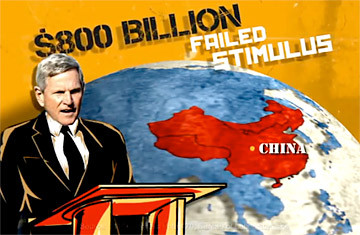
A frame from an attack ad aimed at Rep. Barron Hill (D-IN) who is being challenged by Republican Todd Young
The National Republican Congressional Committee (NRCC) has borrowed a populist Democratic theme for its latest round of attack ads, featuring red flags, menacing-sounding songs, and Asian calligraphy fonts to accuse vulnerable House incumbents are outsourcing jobs to you-know-where.
"Tim Walz helped create jobs in China!" "Mike McIntyre: Jobs in China, not North Carolina." The brassiest spot ends with a cartoon image of Cultural Revolution-style upraised fists: "He's created massive debt here, while he created renewable energy jobs over there. Barron Hill: For Indiana, or China?"
These cookie-cutter ads, to put it mildly, are half-baked. But they come with an interesting back story. The renewable energy program that the NRCC is trashing was part of President Obama's stimulus bill — or, as the ads call it, "the $800 billion failed stimulus." It's helped prevent the collapse of the American wind industry, and it's created thousands of American jobs; like the stimulus in general, it's helped advance Obama's long-term goal of weaning the economy off carbon as well as his short-term goal of saving the economy from a second Great Depression. But like the stimulus in general, it's also creating political headaches for Democrats — at least partly self-inflicted.
"These ads are completely at odds with reality," says Liz Salerno, director of industry data and analysis for the American Wind Energy Association. "This myth about jobs has just been snowballing. It couldn't be more opposite to the facts."
For what it's worth, here are some facts.
When credit markets froze in 2008, the U.S. wind industry froze as well. Since the first Bush Administration, Congress had extended bipartisan tax credits to promote renewable energy projects, but after the financial meltdown those credits became virtually unusable; when no one has profits, no one needs tax credits. Wind projects were stalling, and turbines the size of 747's were lying in fields; the industry was bracing for a 50% decline in new capacity in 2009. So the American Recovery and Reinvestment Act provided nearly $2 billion in direct grants to wind projects, in effect "monetizing" the tax credits.
The results were immediate and impressive. The industry came back from the dead to add a record 10,000 megawatts in 2009, almost a 20% increase. AWEA credits the stimulus with saving at least 40,000 jobs in construction, engineering, trucking and yes, manufacturing. According to the Department of Energy, the U.S. only imported 40% of the components for its wind turbines in 2009, down from about 80% in 2006. And according to the International Trade Commission, less than 5% of those components came from China. In a Facebook posting in February that helped inspire the Republican wind-bashing, Sarah Palin claimed that "80% of the $2 billion they spent on alternative energy went to purchase wind turbines built in China." In fact, only 3 of America's 33,000 turbines were built in China.
The case of Iberdrola Renewables, headquartered in Portland, Ore., helps illustrate the program's impact. After Lehman Brothers collapsed in September 2008, Iberdrola delayed 500 megawatts worth of wind projects in Illinois and Texas. "We were reallocating capital around the globe," recalls senior vice president Don Furman. "We were really stuck." But the day the stimulus passed, Iberdrola's chairman announced he would pour $6 billion back into U.S. projects; the company has already generated an additional 1,800 megawatts with stimulus funds, supporting an estimated 9,000 jobs, and it has launched another nine projects in seven states. "Overnight, we were back in business," Furman says. "Without the stimulus, we were looking at drastic cuts."
